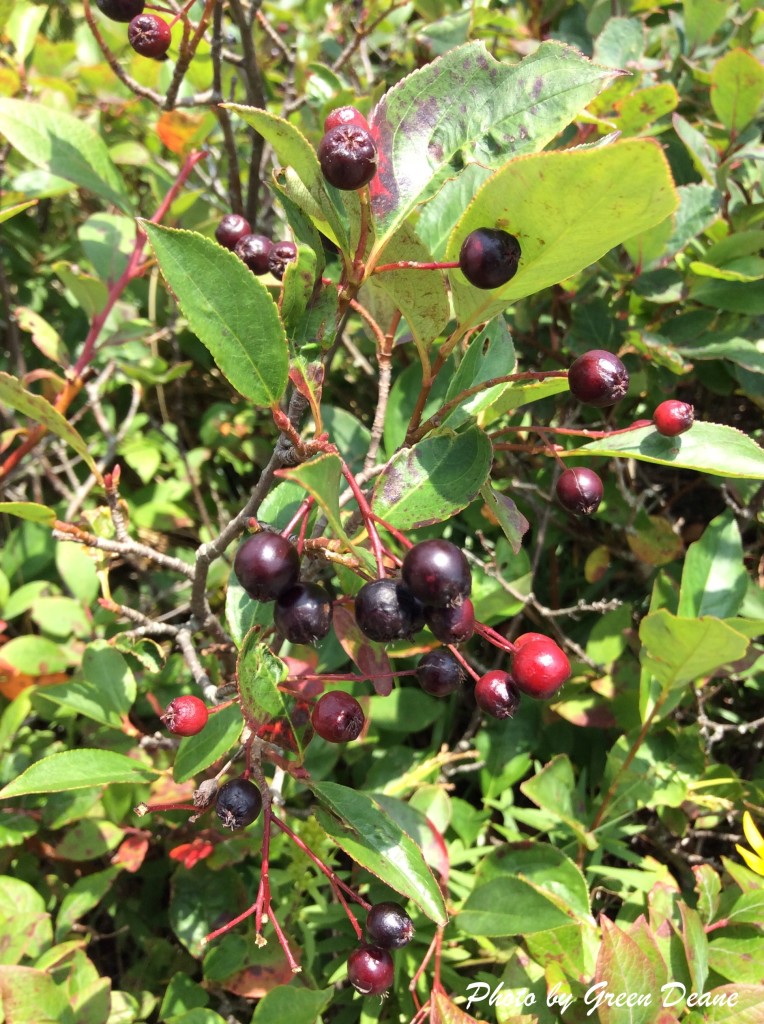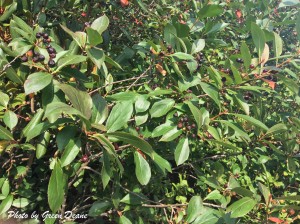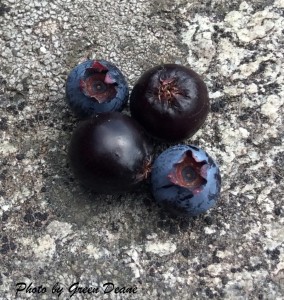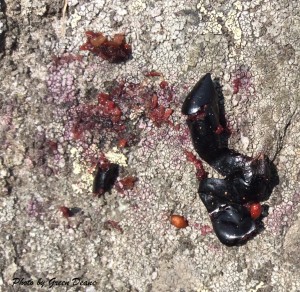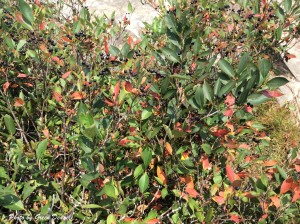It’s a long ways from the mountains of Maine down the Appalachian Trail to the mountains of western North Carolina. It is also a long ways from ones 20’s to ones 60’s. These distances revealed themselves recently when I notice a plant while hiking in the Smokies.
It was familiar but not familiar, a wrong plant in the wrong place I thought. But it was the right plant in the right place, kind of. The problem was I had 40 years of fog in my memory. Helping me sort out the mystery was Doug Elliott, edible plant expert, story-teller and long-time resident of North Carolina. He and his wife Yanna were kind enough to have me and my friend Kelly over to their place in a “holler.” Besides a close up view of their homestead and a taste of sumptuous food I got to ask Doug about my mountain-top mystery. ‘Sounds like an Aronia,’ he said, ‘with the unfortunate name of chokeberry.’ He got it right. The fog began to clear.
What confounded me is that the Aronia is generally thought of as a northern plant and quite common in my native state of Maine. And while North Carolina is not balmy in the winter it’s not the deep freeze New England can be… unless one goes up. Going up 1,000 feet takes you north about 700 miles in climate and season which effects the flora and fauna. Thus the Aronia is a northern genus but it creeps down the spine of the Appalachian Mountains, thriving in the cooler higher altitudes. It was until recently a much over-looked species. In fact, if a big pharmaceutical company could invent a plant it would be the Aronia.
Much like Hawthorns botanists can’t agree on just how many Aronia there are though their numbers are dramatically far less than Hawthorns. There is a red variety, a purple variety, and a black one… maybe… and lot of commercial cultivars and a few natural hybrids and regional genetic differences. But the main point is their edible bitter berries are one of the richest sources of the stuff we — at the moment — think are good for us: Anthocyanins. They are water-soluble pigments that protect our cells from free radicals. Anthocyanins are the main reason, for example, why blueberries are blue and why they are good for us. In fact, Aronia berries have greater antioxidant activity than blueberries and cranberries (five times higher than each) and higher antioxidant activity than pomegranates, strawberries, cherries, even the vaunted goji berry. No fruit grown in a temperate climate has more antioxidants and flavonoids. Though bitter the berries can range from 12 to 20 percent sugar and per 100 fresh grams have 560 to 1059 mg of anthocyanins. It’s no wonder they are being cultivated in many states.
One species of Aronia, A. melanocarpa, has been well-investigated. It not only has anthocyanins but a host of potential positive chemicals including blue Malvidin, Caffeic Acid (an anti-oxidant also found in wine) blue Delphinidin, dark red-purple Cyanidin-3-Galactoside, and Epicatechin, an anti-oxidant found in chocolate. We may not be able to pronounce them but they are anti-… anti-bacterial, anti-viral, anti-arterial plaque, anti-cholesterol, anti-cancer, anti-flu, anti-E coli, anti-high blood sugar, anti-herpes, anti-HIV, anti-Crohn’s Disease as well as improving insulin production while protecting the liver and the stomach. No toxic effects are reported and the genus is naturally pest resistant. That’s quite a lot for a nondescript plant I saw on a mountain top.
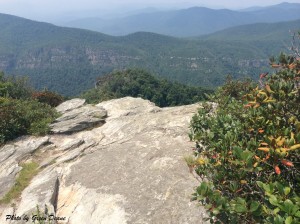
Typical environment for the Black Chokeberry in its southern range. The chokeberry is on the right. Photo by Green Deane
The common name chokeberry is self-evident. The berries are tart and bitter and it’s difficult to choke them down. But they can be made into jams, jellies, juice (by itself or blended) pies and other baked goods. They are also made into wine, stronger alcoholic beverages, pickles, flavoring for ice cream and yogurt and used as a natural food coloring. Among native Americans the Abnaki and Potawatomi ate them for food. Wildlife that live in them or eat the leaves or berries include the white-tailed deer, rabbits, ruffed grouse, sharp-tailed grouse and prairie chickens. The genus name comes from “aria” which is the Greek name for the mountain ash (Sorbus aria.) The red variety of the Aronia has red fruit similar to the red fruit of the Mountain Ash thus the base word was borrowed. Melanocarpa is also Greek meaning black fruit… So Aronia melanocarpa means by intent Red Fruit Black Fruit which is somewhat descriptive but not too inventive. Mountain Ash Black Fruit is just confusing. To get away from the name chokeberry, which people confuse with chokecherry, some have taken to calling it “Aroniaberry” but it hasn’t caught on. Some botanists also put them in the genus Photinia and that is by no means settled. Other botanical names for the Chokeberry have been Aronia arbutifolia (the red one) Aronia nigra, Photinia melanocarpa, Pyrus arbutifolia (red) Pyrus melanocarpa, and Sorbus melanocarpa. A. prunifolia and A. floribunda might be hybrids.
Here are some key identification differences between the Black Chokeberry and the Red Chokeberry:
The Black Chokeberry produces larger fruits that mature to purplish-black, while red chokeberry produces smaller fruits that mature to red;
Black Chokeberry’s fruits mature in late summer and then shrivel and drop, while red chokeberry’s fruits mature in fall and persist into winter;
Black Chokeberry is glabrous (not hairy) while red chokeberry is pubescent (hairy;)
Black Chokeberry plants tend to have a more rounded shape and remain more fully leaved to the base, while the red chokeberry is more upright and tends to be bare at the base;
The Black Chokeberry is naturally found in both wet and dry soils, while Red Chokeberry is found mostly in wet soils. On the mountain tops of North Carolina I saw only Black Chokeberries. Still confused? Know the black and red forms can hybridized. Several cultivars are also available. To be clear, while the research has been on the darker berries the red and the darker-colored berries are edible.
Green Deane’s Itemized Plant Profile
IDENTIFICATION:
Black Chokeberry: a multi-stemmed shrub, deciduous, eastern North American. Four to eight feet, can form dense colonies. Leaves alternate, 1–3 inches in length, 3/4–2 inches in width, oval but narrower at the base than near the tip, fine, regular teeth, top surface dark green, shiny with dark glands on the upper surface of the midrib. Lower surface lighter green, both sides non-hairy. Flowers have five white petals, many pink stamens. Berries 1/3 – 1/2 inch diameter, glossy and black when ripe, hang down in clusters from red pedicels, 30 or so fruits per cluster, one to five seeds each.
TIME OF YEAR:
Flowers open mid-May, fruits usually mature by August
ENVIRONMENT:
Hardy to USDA zone 3 which is to -40 degrees F. Moderately tolerant of shade, prefers moist acid soils from low wet areas to dry sandy slopes meaning bogs, swamps, low wooded areas and clearings as well as dry rocky slopes, bluffs and cliffs. Also found beside roads and power line rights of way. Tolerant of salt spray, drought and soil compaction. While the Black Chokeberry can be found in wet and dry conditions the Red Chokeberry is usually found in wet conditions and rarely in dry areas. The red variety is more tolerant of heat. The genus is found in the eastern half of the United States, New England south and west to Texas, down the Appalachian Mountains to Georgia and reportedly into north Florida. Aronias can be used in landscaping and some have brilliant fall foliage.
METHOD OF PREPARATION
Can be eaten raw but bitter. Better made into jams and jellies, juice, wine and used in baked goods.

